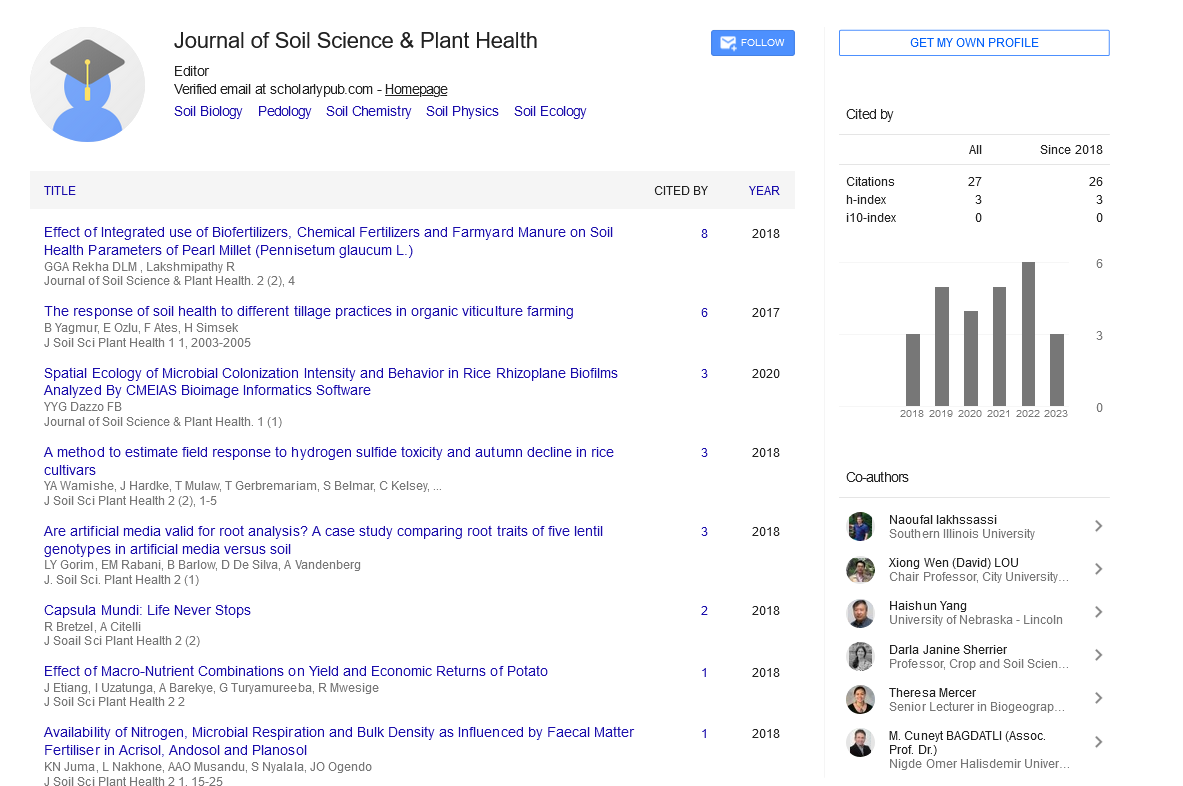Commentary, J Soil Sci Plant Health Vol: 8 Issue: 1
Soil Erosion Control and Sustainable Land Management
Yoong Chen*
Department of Agriculture and Biotechnology, Zhejiang University, No. 38 Zheda Road, Hangzhou 310058, Zhejiang Province, China
- *Corresponding Author:
- Yoong Chen
Department of Agriculture and Biotechnology,
Zhejiang University,
No. 38 Zheda Road,
Hangzhou 310058,
Zhejiang Province,
China
E-mail: yoong23@gmail.com
Received date: 27 October, 2023, Manuscript No. JSPH-23-118474;
Editor assigned date: 30 October, 2023, PreQC No. JSPH-23-118474 (PQ);
Reviewed date: 13 November, 2023, QC No. JSPH-23-118474;
Revised date: 05 January, 2024, Manuscript No. JSPH-23-118474 (R);
Published date: 12 January, 2024, DOI: 10.4172/jsph.1000219
Citation: Chen Y (2024) Soil Erosion Control and Sustainable Land Management. J Soil Sci Plant Health J 8:1.
Description
Soil erosion is a natural geological process, but human activities have accelerated it to alarming rates. Erosion leads to the loss of fertile topsoil, which is vital for agriculture and ecosystems. Sustainable land management practices play a crucial role in preventing soil erosion and maintaining soil health. The impacts of soil erosion, the factors contributing to it, and the strategies for sustainable land management to control erosion. To combat soil erosion and promote sustainable land management, a combination of techniques and practices has been developed. The importance of soil erosion control and sustainable land management and highlights key strategies for mitigating erosion and conserving soil resources. Soil erosion is the process by which the top layer of soil is removed or displaced by natural forces such as water, wind, and human activities. It can be categorized into several types, including water erosion (sheet, rill, and gully erosion) and wind erosion.
Soil erosion poses a range of significant challenges: Erosion removes the nutrient-rich topsoil layer, reducing soil fertility and agricultural productivity.
Eroded soil particles can clog water bodies, affecting water quality, aquatic life, and navigation. Sediment buildup in rivers and streams can raise water levels during heavy rainfall, increasing the risk of flooding. Erosion can disrupt ecosystems and lead to habitat degradation, impacting plant and animal populations. Eroded soil often contains stored carbon, which is released into the atmosphere as carbon dioxide, contributing to climate change.
Several factors contribute to soil erosion: Intensity and frequency of rainfall events influence erosion rates. The texture, structure, and organic matter content of soil affect its erodibility. Steep slopes are more prone to erosion, especially in hilly or mountainous regions.
Deforestation, overgrazing, and inappropriate agricultural practices can increase soil erosion. Paved surfaces and construction projects can increase runoff and erosion.
Effective soil erosion control and sustainable land management practices are essential for preserving soil health and preventing further erosion: Planting crops in rows that follow the contour of the land reduces water runoff and erosion. Constructing terraces on slopes helps slow down water and reduce soil loss. Planting cover crops during fallow periods can protect the soil from erosion and improve its structure. Reducing or eliminating tillage minimizes soil disturbance and erosion. Planting vegetation along water bodies acts as a buffer, reducing sediment runoff. Protecting riparian zones along rivers and streams helps stabilize banks and reduce erosion. Restoring forests or afforestation efforts help stabilize soil and reduce erosion. Regular soil testing allows for precise nutrient management, reducing the need for over-application of fertilizers.
Conservation practices
Diversifying crops in a field reduces soil erosion and nutrient depletion. Installing structures like silt fences and check dams can help control erosion. Constructing sediment basins can capture eroded material before it enters water bodies. Planting grass in natural drainage pathways helps slow water runoff and trap sediment. Sustainable land management also requires community engagement and supportive policies:
Education and outreach: Public awareness campaigns can educate communities about the impacts of erosion and the importance of sustainable land management.
Legislation and regulation: Government policies and regulations can encourage or enforce erosion control and sustainable land management practices.
Incentives: Financial incentives, such as subsidies or tax breaks, can motivate landowners to adopt sustainable practices.
Conclusion
Soil erosion is a critical environmental issue with far-reaching implications for agriculture, ecosystems, and climate change. Sustainable land management practices, along with community engagement and policy support, are crucial for controlling erosion and preserving soil health. The implementation of soil erosion control practices, coupled with sustainable land management, is essential for preserving soil health, maintaining agricultural productivity, and protecting natural habitats. By adopting these practices and working collectively, we can mitigate the impacts of soil erosion and promote long-term sustainability of our lands and resources.
 Spanish
Spanish  Chinese
Chinese  Russian
Russian  German
German  French
French  Japanese
Japanese  Portuguese
Portuguese  Hindi
Hindi 